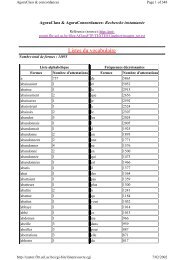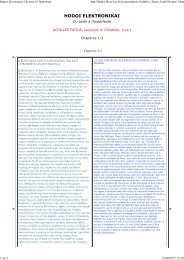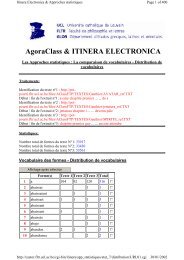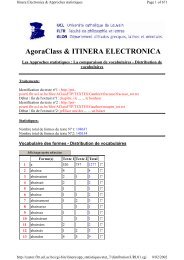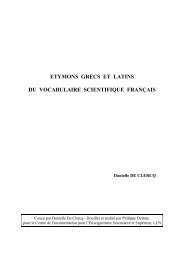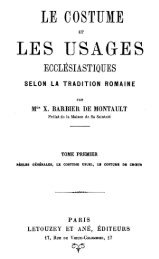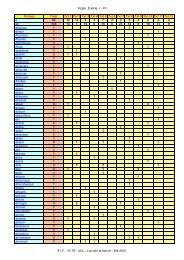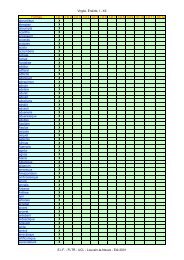The Etymologies of Isidore of Seville - Pot-pourri
The Etymologies of Isidore of Seville - Pot-pourri
The Etymologies of Isidore of Seville - Pot-pourri
Create successful ePaper yourself
Turn your PDF publications into a flip-book with our unique Google optimized e-Paper software.
611/12:Death <strong>of</strong> Gundemar. Sisebut becomes king.<br />
613: <strong>Isidore</strong>dedicates De Natura Rerum to Sisebut.<br />
621: Sisebutdies. Reccared II becomes king and dies<br />
shortly thereafter. Suinthila becomes king.<br />
Few details can be given about <strong>Isidore</strong>’s life with any<br />
certainty. He was born some time around 560,aboutthe<br />
time when his father Severianus relocated the family to<br />
<strong>Seville</strong> from Cartagena, where invading Byzantine forces<br />
had taken control. <strong>Isidore</strong>’s parents died while he was still<br />
young, and he was brought up and educated in <strong>Seville</strong><br />
under the care <strong>of</strong> his older brother Leander, very likely in<br />
the monastery school where Leander was abbot (Riché<br />
1976:289).<br />
Leander, who became Bishop <strong>of</strong> <strong>Seville</strong> before 580,<br />
was an active and influential churchman. 15 He wasapersonal<br />
friend <strong>of</strong>Gregory,laterPopeGregoryI,whomhe<br />
encountered on a visit to Constantinople and who dedicated<br />
his Moralia to Leander. A connection <strong>of</strong> greater<br />
consequence for the kingdom <strong>of</strong> Spain was Leander’s<br />
friendship with King Leovigild’s sons Hermenigild and<br />
Reccared, the future king; it was under Leander’s guidance<br />
that both his royal friends converted from Arianism<br />
to Catholicism.<br />
After Leander’s death, and shortly before Reccared<br />
died, <strong>Isidore</strong> was made Bishop <strong>of</strong> <strong>Seville</strong>, most likely in<br />
15 Good biographies <strong>of</strong> Leander, with accounts <strong>of</strong> his combat<br />
against Arianism and his writings, are L. Navarra, Leandro di Siviglia:<br />
Pr<strong>of</strong>ilo storico-letterario (Rome, 1987), which prints and translates his<br />
Homilia in Laudem Ecclesiae, and J. Madoz, “San Leandro de Sevilla,”<br />
Estudios Eclesiásticos 56 (1981): 415–53, printing the basic documentary<br />
sources for Leander’s career.<br />
16 <strong>The</strong> kind <strong>of</strong> Greek known by <strong>Isidore</strong> and others from the sixth<br />
century on has been the subject <strong>of</strong> a number <strong>of</strong> studies: see Bisch<strong>of</strong>f<br />
1967:246–75, Riché 1976:44–45, W.Berschin, Griechisch-lateinisches<br />
Mittelalter, von Hieronymus zu Nikolaus von Kues (Bern and Munich,<br />
1980), revised and expanded by the author and trans. J. C. Frakes as<br />
Greek Letters and the Latin Middle Ages, from Jerome to Nicholas <strong>of</strong><br />
Cusa (Washington, DC, 1988) and especially M. Herren and S. A.<br />
Brown, eds., <strong>The</strong> Sacred Nectar <strong>of</strong> the Greeks: <strong>The</strong> Study <strong>of</strong> Greek<br />
in the West in the Early Middle Ages (London, 1988), esp. Herren’s<br />
introduction (v–xii), and the studies by Dionisotti (1–56), Herren<br />
(57–84), Berschin (85–104), and Riché(143–68)inthe same volume.<br />
<strong>Isidore</strong>’s knowledge <strong>of</strong> Hebrew was restricted to names interpreted<br />
by Jerome (Riché 1976:302).<br />
Life and works<br />
Life and works 7<br />
624: Suinthila drives the Byzantines completely out <strong>of</strong><br />
Spain.<br />
631:Suinthila is deposed. Sisenand becomes king.<br />
636:Sisenand dies. <strong>Isidore</strong> dies.<br />
the year 600.His other brother, Fulgentius, as well as his<br />
sister Florentina, also chose to go into the Church; Fulgentius<br />
became Bishop <strong>of</strong> Ecija and Florentina entered a<br />
nunnery. As one <strong>of</strong> the leading churchmen in the country,<br />
<strong>Isidore</strong> presided over important Church councils in<br />
<strong>Seville</strong> (in 619)andToledo (in 633). <strong>The</strong> close ties that had<br />
been established between the Visigothic monarchy and<br />
the Catholic Church after Reccared’s conversion make it<br />
likely that <strong>Isidore</strong> had some political influence as well.<br />
Hisrelationship with King Sisebut (reigned 612–621)was<br />
particularly close, extending beyond practical matters <strong>of</strong><br />
government to a personal friendship based on shared<br />
intellectual interests. Also important was his friendship<br />
with his younger colleague, Braulio, who was in <strong>Seville</strong><br />
with <strong>Isidore</strong> until 619,when he became archdeacon (and<br />
later, in 631, bishop) <strong>of</strong> the Church in Saragossa. <strong>The</strong>ir<br />
correspondence (see the letters attached to the <strong>Etymologies</strong><br />
in the Appendix) providesavaluable glimpse <strong>of</strong><br />
<strong>Isidore</strong>’s personality and daily life.<br />
<strong>Isidore</strong> was deeply admired by his contemporaries<br />
for his scholarship and intellectual gifts. Although their<br />
praise for his Greek and Hebrew is perhaps unmerited<br />
(his knowledge <strong>of</strong> these languages appears to have<br />
extended only to disconnected Greek terms and phrases,<br />
and a smattering <strong>of</strong> Hebrew words), the breadth <strong>of</strong> his<br />
learning is nonetheless impressive. 16 He was happy to<br />
draw on pagan authors as well as Church Fathers, and<br />
was familiar with works as various as Martial’s Epigrams,<br />
Tertullian’s On Spectacles, andPliny the Elder’s Natural<br />
History. In spite <strong>of</strong> the demands <strong>of</strong> his episcopal <strong>of</strong>fice,<br />
<strong>Isidore</strong> nevertheless found time to produce a substantial<br />
body <strong>of</strong> writing. Braulio compiled a list <strong>of</strong> these<br />
works, the Renotatio Isidori, presented in the order in<br />
which they were written, shortly after <strong>Isidore</strong>’s death<br />
in 636:<br />
<strong>Isidore</strong>, an excellent man, bishop <strong>of</strong> the Church at<br />
<strong>Seville</strong>, successor to and brother <strong>of</strong> Bishop Leander,<br />
flourished from the time <strong>of</strong> the Emperor Mauritius and





